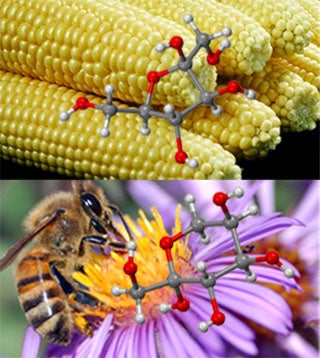
Would sugar by any other name taste as sweet? We learn in lecture 12 that the fructose in honey is a pyranose, whereas the fructose in corn syrup is a furanose, and one actually is sweeter. (Collage by MIT OpenCourseWare. Images by Benjah-bmm27, Severnjc, & USDA. Wikimedia Commons, public domain.)
Instructor(s)
Prof. Michael Yaffe
Prof. Matthew Vander Heiden
MIT Course Number
7.05
As Taught In
Spring 2020
Level
Undergraduate
Course Description
Course Features
- Selected video lectures
- Captions/transcript
- Assignments: problem sets with solutions
- Exams (no solutions)
Course Description
This course focuses on contributions of biochemistry toward an understanding of the structure and functioning of organisms, tissues, and cells. Topics include:
- Chemistry and functions of constituents of cells and tissues and the chemical and physical-chemical basis for the structures of nucleic acids, proteins, and carbohydrates.
- Basic enzymology and biochemical reaction mechanisms involved in macromolecular synthesis and degradation, signaling, transport, and movement.
- General metabolism of carbohydrates, fats, and nitrogen-containing materials such as amino acids, proteins, and related compounds.
NOTE: The first half of this course, taught by Prof. Yaffe, is available on the MITx platform as 7.05x Biochemistry: Biomolecules, Methods, and Mechanisms. This OCW website provides content primarily from the second half with Prof. Vander Heiden, which focuses on metabolism.


